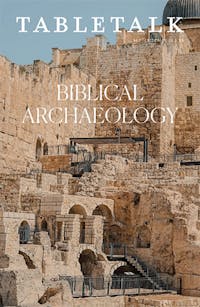
Request your free, three-month trial to Tabletalk magazine. You’ll receive the print issue monthly and gain immediate digital access to decades of archives. This trial is risk-free. No credit card required.
Try Tabletalk NowAlready receive Tabletalk magazine every month?
Verify your email address to gain unlimited access.
The Rosetta Stone was discovered in Egypt in 1799 by French soldiers in Napoleon’s invasion force. Though badly damaged when excavated, it originally stood almost five feet tall and contained a priestly inscription from the time of Ptolemy V Epiphanes in 196 BC. Three writing systems were used to record the decree: Greek, the Egyptian Demotic script, and Egyptian hieroglyphics. Historians had long been fascinated by hieroglyphics but had not yet deciphered them. The Rosetta Stone changed all that.
Already in the first century BC, the Greek historian Diodorus Siculus argued that Egyptians did not write using alphabetic or syllabic characters but strung word pictures together to express complex concepts. Scholars into the sixteenth and seventeenth centuries AD attempted to translate hieroglyphics accordingly. But when the English linguist Thomas Young began to connect identical sequences of hieroglyphs on the Rosetta Stone to repeated proper names in the Greek inscription, he noticed that the hieroglyphs spelled these names alphabetically. Nine years later, Jean-François Champollion applied Young’s work to a range of inscriptions and determined that Egyptian hieroglyphics were entirely alphabetic. He had cracked the code.

With the decipherment of hieroglyphics, a new world was opened to historians. Since hieroglyphic inscriptions are almost ubiquitous on monumental architecture from ancient Egypt, one simply cannot overestimate the significance of this find. Obelisks, tombs, temples, pyramids, and other objects now told stories of ancient Egypt previously unheard. And while the improved general knowledge of Egyptian history and culture has proved invaluable for biblical scholarship, several finds intersect directly with Old Testament history:
- The fifteenth-century-BC temple in Soleb (modern-day Nubia) contains a hieroglyphic inscription wherein Pharaoh Amenhotep III claimed victory over an area described as “the land of the Shasu of Yahweh,” corroborating that around 1400 BC, a Semitic people group from Canaan was associated with the God of the Old Testament.
- The late-thirteenth-century-BC stelae erected by Pharaoh Merneptah claimed victory over a group of people living in Canaan that were named “Israel.”
- The tenth-century-BC reliefs from the temple of Amun-Ra at Karnak records Pharaoh Shishak’s claim to have conquered numerous sites in Israel and Judah, including a region tantalizingly translated as “the highlands of David.”
The Rosetta Stone has enabled us to learn a tremendous amount about Egypt, a country that interacted with ancient Israel in very significant ways throughout its long history.
